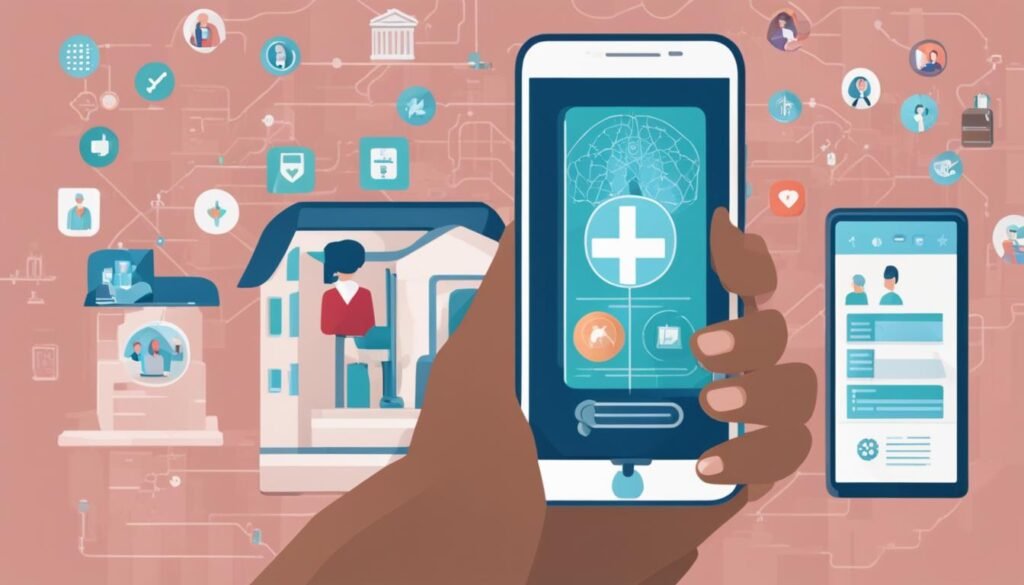Telemedicine has revolutionized the way healthcare is delivered in Mexico. With the rise of modern technology, telemedicine offers a convenient and accessible way to access healthcare services without being physically present in the same room as the doctor. Telemedicine enables patients to consult with healthcare professionals, receive diagnoses, and get prescriptions from the comfort of their own homes.
Telemedicine has removed geographic barriers and helped to increase access to healthcare services, especially in rural areas where medical professionals are scarce. By providing remote access to healthcare services, telemedicine has also enhanced the healthcare experience for patients, making it easier for them to receive the care they need.
Key Takeaways:
- Telemedicine has transformed the healthcare industry in Mexico, making healthcare services more accessible and convenient for patients.
- Telemedicine enhances the healthcare experience by enabling remote access to healthcare services.
- Geographic barriers, especially in rural areas, are removed with telemedicine, increasing access to medical professionals.
Telemedicine and Telehealth: Understanding the Difference
Telemedicine and telehealth are terms that are often used interchangeably, but they do have distinct differences. Telemedicine refers specifically to remote clinical services, such as virtual doctor consultations and remote diagnosis through technology, for the purpose of healthcare provision. On the other hand, telehealth is a broader term that includes remote healthcare services, education, and administration, beyond clinical services.
While both telemedicine and telehealth utilize technology to provide care remotely, telehealth encompasses a wider range of services, including, but not limited to, health education, administrative consultations, and non-clinical consultations. Telemedicine services, however, are primarily related to providing clinical care using technology.
The distinction between telemedicine and telehealth is important when it comes to reimbursement and regulations. Understanding the nuances between these two terms is vital for healthcare providers to ensure proper billing and compliance with regulatory policies.
According to the World Health Organization (WHO), telemedicine and telehealth have the potential to significantly improve healthcare delivery, particularly in low-income and remote settings. By facilitating remote medical consultations and medical education, telemedicine and telehealth can expand access to healthcare services and improve health outcomes.
The Benefits of Telemedicine for Healthcare Providers
Telemedicine has numerous benefits, making it a valuable tool for healthcare providers. These benefits are:
| Benefit | Description |
|---|---|
| Increased Efficiency | Telemedicine enables healthcare providers to conduct appointments online, reducing the need for in-person visits. This not only saves time but also promotes better resource utilization and boosts productivity. |
| Expanded Reach | Telemedicine allows healthcare providers to extend their services beyond their physical locations, reaching patients in remote or rural areas. This expands their patient base, improves access to care, and helps to address disparities in healthcare provision. |
| Improved Patient Care | Telemedicine enables healthcare providers to offer virtual visits and remote clinical services, promoting easier access to medical care. It also facilitates remote monitoring and follow-up care, improving outcomes for patients with chronic diseases. |
Overall, telemedicine is a beneficial tool for healthcare providers. It empowers them to offer quality care conveniently and efficiently. As such, its adoption is critical to the evolution of Mexico’s healthcare system.
The Role of Information Technologies in Telemedicine
Information technologies have played a crucial role in enabling telemedicine services. Using technology to provide virtual medical consultations, remote monitoring and telemedicine appointment scheduling, healthcare providers can now serve patients better and more efficiently.
There are various technological tools and platforms in use currently, allowing doctors to treat patients without being in the same physical location. These platforms may employ video conferencing codecs, messaging services, encrypted email, networked medical devices, mobile applications, patient portals, and others. Telemedicine technology can be characterized as:
| Characterization | Description |
|---|---|
| Real-Time | Well suited for providing immediate care such as emergency consultation, subject to both patients and medical professionals having real-time communication technology. |
| Store and Forward | Involves capturing medical data (e.g., images, videos, or medical history) and transmitting it asynchronously to a medical specialist for evaluation. This method allows complex cases to be evaluated by multiple medical professionals. |
| Remote Monitoring | Involves the use of mobile medical devices designed to collect patient health data, which is then transmitted to healthcare providers. This enables doctors to remotely monitor the patient’s vital signs, providing convenient and unobtrusive healthcare services. |
The effectiveness of telemedicine technology depends on several factors, including the bandwidth of the internet connection, the devices being used, and the level of integration with the existing healthcare infrastructure. However, as technology continues to evolve and improve, so too will telemedicine services, making modern healthcare more accessible and efficient than ever before.
Telemedicine Applications and Use Cases
Telemedicine is a versatile tool that finds application in various specialties and healthcare settings, allowing healthcare providers to deliver quality medical care remotely. The use of telemedicine has increased significantly in recent years, driven by the need to improve access to healthcare services and reduce the burden on traditional healthcare facilities.
Patient Monitoring and Chronic Care Management
Telemedicine allows for continuous monitoring of a patient’s health status, providing healthcare providers with real-time data and enabling them to make informed medical decisions. Telemedicine also proves useful in the management of chronic conditions, allowing patients to monitor and track their symptoms while reducing the need for in-person appointments. This not only enhances patient care but also helps optimize healthcare resources.
Mental Health Consultations
The use of telemedicine has revolutionized how mental health services are delivered, allowing patients to receive remote psychological and psychiatric consultations in a secure and confidential environment. Telemedicine has helped reduce the stigma associated with mental health conditions and increased access to care for patients in underserved communities. With telemedicine, mental health professionals can reach a broader patient population, delivering timely medical care to those in need.
Remote Patient Consultations
Telemedicine eliminates the geographical barriers that limit access to medical care by enabling remote patient consultations. Patients can receive medical advice from the comfort of their homes without having to travel long distances or wait in long queues. Telemedicine consultations are particularly useful for patients who require regular check-ups and follow-ups, enabling physicians to assess their health status without the need for in-person appointments, thus saving both time and resources.
Primary Care and Specialties
Telemedicine is increasingly being used to deliver primary care services, enabling healthcare providers to manage acute and chronic conditions, provide preventive care, and wellness services. Telemedicine also has applications in various specialties such as cardiology, dermatology, and radiology, where remote consultations can provide insights on complex medical conditions. The use of telemedicine ensures that patients receive timely and affordable medical care, improving health outcomes and patient satisfaction.
“Telemedicine is a versatile tool that finds application in various specialties and healthcare settings, allowing healthcare providers to deliver quality medical care remotely.”
The History and Evolution of Telemedicine
Telemedicine is not a new concept, and its roots can be traced back to the early 20th century when doctors first experimented with transmitting radiographic images through telephone lines. However, it was not until the advent of the internet and information technologies that telemedicine became a practical and viable solution for modern healthcare challenges.
One of the earliest documented uses of telemedicine occurred in Mexico in the 1960s, when doctors used two-way radio to provide medical assistance to miners working in remote areas. This practice later expanded to other areas of Mexico, particularly rural communities with limited access to healthcare services.
Over the years, telemedicine has continued to evolve and adapt to new technologies, including videoconferencing, remote monitoring, and mobile health applications. Today, telemedicine stands at the forefront of healthcare innovation, providing solutions to issues such as provider shortages, rising costs, and inadequate access to care.

Telemedicine practice has also been influenced by changing regulatory landscapes, both nationally and globally. In Mexico, the government has made significant efforts to promote telemedicine as a means of increasing healthcare access, particularly in rural areas. The 2019-2024 National Health Plan includes a specific goal of ensuring that all Mexicans have access to telemedicine services by the end of 2024.
The history and evolution of telemedicine demonstrate its potential to revolutionize healthcare delivery, improving access to care, enhancing patient outcomes, and reducing costs. As telemedicine technologies continue to advance, it is likely that their applications will expand, enabling even greater improvements in healthcare services.
Telemedicine and Telehealth in Mexico’s Healthcare System
Telemedicine has played a significant role in the evolution of Mexico’s healthcare system. As a vast country with a diverse population, Mexico faces several healthcare challenges, such as providing access to quality healthcare services to people living in rural areas. Telemedicine has been a crucial tool to bridge this gap and improve access to care.
For example, the Mexican government implemented a national telemedicine program, the “Programa de Telemedicina,” in 2015. The program aimed to provide comprehensive primary care services to remote areas and overcome geographical barriers that previously limited access to traditional healthcare services.
The telemedicine program has demonstrated promising results, improving access to care and reducing healthcare costs. Moreover, telemedicine has proven useful in emergency and disaster situations, where timely access to medical services is crucial. Telemedicine has enabled healthcare professionals to deliver remote clinical services, such as triaging patients, conducting remote consultations, and providing remote monitoring services.
Despite these benefits, telemedicine still faces several challenges in Mexico’s healthcare system. One of the significant barriers is the lack of proper reimbursement policies for telemedicine services, which limits healthcare providers’ incentives to adopt telemedicine. Additionally, not all patients have access to appropriate technology, such as smartphones or stable internet connections, which may limit their ability to use telemedicine services.
However, despite these challenges, telemedicine is increasingly becoming an integral part of Mexico’s healthcare system, especially in the wake of the COVID-19 pandemic. Telemedicine offers a convenient and accessible way of delivering healthcare services, improving healthcare outcomes for patients in Mexico.
Telemedicine Technologies and Platforms
Telemedicine relies heavily on technology to provide remote healthcare services to patients. A wide range of telemedicine technologies and platforms are available, each with unique features and functions. These tools enable healthcare providers to offer virtual consultations, diagnose and treat patients, and monitor their health remotely.
Some of the most common telemedicine technologies include:
- Telemedicine apps: These are mobile applications that patients can use to connect with healthcare providers. Patients can schedule appointments, message their medical team, and access their medical records.
- Remote monitoring devices: These devices collect and transmit vital signs and other health data to healthcare providers in real-time. Examples include blood pressure monitors, EKG machines, and glucose monitors.
- Telemedicine platforms: These are online platforms that connect patients with healthcare providers. These platforms enable patients to have virtual appointments with their doctors, receive diagnoses, and get prescriptions.
- Secure messaging: This technology allows patients to communicate with their healthcare team in a secure and private manner. Patients can send and receive messages, images, and other medical data through this platform.
As the use of telemedicine continues to grow, there are numerous telemedicine platforms available today, some of which are specially designed for specific specialties. These platforms not only provide a medium for patients to connect with healthcare providers, but also enable real-time consultations, electronic prescriptions, and scheduling of appointments.
Healthcare providers must ensure that the telemedicine technologies and platforms they use are HIPAA compliant. Compliance with HIPAA regulations ensures the security and confidentiality of patient data, protecting it from unauthorized access. By leveraging appropriate telemedicine solutions, healthcare providers can deliver high-quality healthcare services while improving efficiency and reducing costs.
Telemedicine: Enhancing Patient Care
The primary goal of telemedicine is to improve patient care and increase access to medical services, particularly in remote and underserved areas. Telemedicine provides a convenient and effective way for patients to receive medical care without leaving their homes. This is especially important for patients with chronic conditions who require ongoing monitoring and management.
Telemedicine enables healthcare professionals to offer virtual consultations and remote monitoring, improving the quality of care and reducing the risk of complications. By providing patients with timely access to medical information and support, telemedicine empowers patients to take charge of their health and wellbeing.
Studies have shown that telemedicine can result in better health outcomes, decreased hospital admissions, and reduced healthcare costs. Telemedicine also has the potential to address the healthcare workforce shortage by enabling healthcare providers to reach a broader patient population.
Examples of Telemedicine in Enhancing Patient Care
One of the areas where telemedicine is making a significant impact is in the management of chronic conditions. Patients with chronic conditions such as diabetes, hypertension, and heart disease require ongoing monitoring and management, which can be challenging in traditional healthcare settings.
Telemedicine allows patients to track their symptoms and vital signs, and share that information with their healthcare providers. This enables providers to monitor patients’ health status remotely and make timely interventions as needed. Patients with chronic conditions who receive care through telemedicine often have better health outcomes, and experience a higher quality of life.
Telemedicine is also proving to be an effective tool for mental health care. Patients with mental health conditions often face significant barriers to accessing care, including stigma and a shortage of mental health providers. Telemedicine offers a secure and confidential way for patients to connect with mental health professionals from the comfort of their own homes.
The Future of Telemedicine in Enhancing Patient Care
The future of telemedicine in enhancing patient care is promising. Advancements in technology are making telemedicine more accessible and user-friendly, increasing its potential to transform the healthcare industry. Telemedicine has the potential to provide patients with continuous access to medical care, improve health outcomes, and reduce healthcare costs.
As telemedicine continues to evolve and gain acceptance, it will become an increasingly essential part of healthcare delivery. By leveraging the power of technology, healthcare providers can enhance patient care, improve access to healthcare services, and ultimately, improve the health and wellbeing of patients across Mexico.
Telemedicine and Telehealth: Expanding Access to Care
One of the most significant benefits of telemedicine and telehealth is the expansion of access to care. These innovative technologies are leveling the playing field for patients in rural and remote areas who often face significant barriers to healthcare services. With telemedicine, patients can access medical expertise from the comfort of their own homes, regardless of their location.
Telemedicine enables remote consultations, online appointments, and virtual health assessments, providing convenient options for patients who cannot travel long distances or prefer not to risk exposure to infectious diseases. This is especially crucial for people with chronic conditions who require regular medical check-ups.
The use of telemedicine and telehealth technologies is also promoting equity in healthcare access. Patients from underserved areas and communities where healthcare infrastructure is scarce can benefit from telemedicine services, potentially avoiding hospitalizations or emergency room visits. Telemedicine can also improve access to specialty care, as patients can easily connect with healthcare providers from different locations.
Telemedicine and telehealth are enhancing access to care, streamlining medical services, and bringing modern healthcare to patients, no matter where they are located. By breaking down geographical barriers and providing convenient options for patients, these technologies are transforming the way healthcare is delivered in Mexico, creating a more accessible and equitable healthcare system that has the potential to improve overall health outcomes.
Telemedicine: Enhancing Health Outcomes
Telemedicine has the potential to significantly improve patient care and health outcomes. By enabling remote access to medical information and providing real-time clinical support, telemedicine enhances the delivery of healthcare services and helps patients achieve better health outcomes.
One of the key benefits of telemedicine is its ability to support proactive patient engagement. Through telemedicine, patients can receive timely medical information and feedback, empowering them to manage their health at their convenience. This approach has proved particularly effective in managing chronic diseases like diabetes and hypertension, where regular monitoring and follow-up care play a crucial role.
Studies have also shown that telemedicine can help reduce hospital readmission rates by providing patients with post-discharge support. By facilitating remote consultations and virtual follow-up appointments, patients can receive ongoing care without the need for a physical visit. This approach not only saves time and resources but also helps improve patient outcomes by ensuring continuity of care.

Telemedicine also benefits patients in remote or underserved areas where access to healthcare is limited. By connecting patients with specialists and healthcare providers remotely, telemedicine expands access to care and ensures that patients receive the medical attention they need. In addition, telemedicine helps reduce the risk of infections and the spread of diseases by reducing the need for in-person visits.
Overall, telemedicine has the potential to significantly improve patient care and health outcomes by providing timely access to medical information, facilitating remote consultations and follow-up care, and expanding access to healthcare services.
Telemedicine: Challenges and Considerations
Although telemedicine has the potential to revolutionize healthcare delivery by supporting remote consultations and increasing access to care, there are several challenges and considerations that must be addressed to ensure its successful implementation.
One of the primary challenges is the lack of regulatory frameworks and policies that specifically govern telemedicine practice. Currently, there is a need to establish guidelines and regulations that protect patient privacy, maintain data security, and ensure that telemedicine services meet appropriate standards of care.
Another challenge is the reimbursement mechanisms for telemedicine services. Although some insurance plans cover telemedicine consultations, there is no universal reimbursement model in place. As a result, practitioners may hesitate to participate in telemedicine consultations due to concerns about income and financial sustainability.
Additionally, technological barriers and limitations, such as inadequate access to high-speed internet and the inability to access telemedicine platforms on certain devices, can impede the adoption and utilization of telemedicine services. Adequate training and support must be provided to healthcare professionals to ensure they can effectively use telemedicine technologies, and patients must have access to the necessary devices and internet infrastructure.
Despite these challenges, it is essential to consider the many benefits that telemedicine can offer, including increased access to care, improved clinical outcomes, and enhanced patient satisfaction. As the healthcare industry continues to evolve, it is crucial to consider how telemedicine can be integrated into existing care models to improve quality, efficiency, and patient outcomes.
Telemedicine in Emergency and Urgent Care Settings
In emergency situations, every second counts. In Mexico, telemedicine has emerged as a viable solution to help healthcare providers deliver timely medical assistance to patients in urgent need. Through the use of telemedicine, medical professionals can evaluate patients remotely and provide quick and efficient interventions.
Telemedicine in emergency care settings comes with numerous benefits. It allows healthcare professionals to prioritize patients based on the severity of their conditions, facilitating prompt interventions and faster recoveries. Additionally, telemedicine enables healthcare providers to manage emergencies in real-time, reduce hospital readmissions, and decrease the risk of healthcare-associated infections.
One of the significant advantages of telemedicine in emergency care settings is the ability to consult specialists and other healthcare professionals remotely. Through telemedicine, emergency healthcare providers can connect with specialists in different fields and seek expert advice, improving the quality of care provided.
“Telemedicine has the potential to reduce costs and increase access to care in emergency and urgent care settings, particularly in rural and remote areas” – Dr. Maria Gonzalez, Emergency Medicine Specialist.
Telemedicine platforms provide features such as electronic health records and remote monitoring technology that enable healthcare practitioners to review patients’ medical history, symptoms, and vital signs before arriving at a diagnosis. This functionality ensures that emergency medical services are tailored to meet each patient’s needs, ultimately resulting in improved patient outcomes.
In conclusion, the application of telemedicine in emergency and urgent care settings in Mexico has revolutionized the healthcare industry, offering patient-centered care that is efficient, effective, and accessible, even in remote locations. Telemedicine can play a critical role in emergency medical services providing an even better quality of care to patients who need it the most.
Telehealth: The Future of Healthcare Delivery
Telehealth is changing the way we access healthcare services, empowering patients to take charge of their well-being from the comfort of their homes. With the advent of telehealth technologies, virtual healthcare is becoming increasingly accessible, offering convenient and cost-effective options for medical consultations and remote monitoring.
As telehealth continues to gain momentum, it is poised to revolutionize the healthcare industry, delivering quality medical care to underserved populations and improving access to care for those in need. By leveraging modern technologies such as videoconferencing, remote monitoring, and mobile health apps, telehealth is breaking down traditional barriers to care, offering a new era of patient-centered medicine.
The future of healthcare delivery is virtual, and telehealth is leading the way. With its potential to increase efficiency, enhance quality of care, and reduce costs, telehealth is the answer to many of the challenges facing healthcare today. It offers a solution to the shortage of healthcare professionals in remote areas, improves access to care for patients with chronic conditions, and provides flexibility and convenience for busy individuals.
Virtual healthcare is not only transforming the way we access medical services, but it is also enhancing the patient experience, placing the patient at the center of medical care. Telehealth empowers patients to take charge of their health, providing them with the tools and resources they need to manage their conditions and improve their quality of life.
Benefits of Telehealth
The benefits of telehealth are numerous:
| Benefits | Explanation |
|---|---|
| Improved access to care | Telehealth enables patients to access medical services remotely, eliminating the need for in-person visits and reducing the burden of travel. |
| Better patient outcomes | Virtual healthcare improves patient outcomes by providing timely access to medical care, enhancing patient engagement, and supporting remote monitoring of chronic conditions. |
| Cost-effective | Telehealth offers cost savings for patients by reducing the need for expensive in-person visits and hospital stays. |
| Flexibility | Virtual healthcare provides flexibility and convenience for patients, allowing them to schedule appointments at a time and location that suits them. |
With the increasing adoption of telehealth technologies, the future of healthcare delivery is brighter than ever. Virtual healthcare is transforming the healthcare industry, empowering patients and healthcare providers alike, improving access to care, and enhancing patient outcomes. The healthcare revolution is here, and telehealth is leading the charge.
Telemedicine and Telehealth: Regulatory Landscape
The regulatory landscape surrounding telemedicine and telehealth is an essential aspect of its implementation process. Governments around the world have recognized the benefits of telemedicine and have created frameworks to govern and regulate its practice. In Mexico, the regulatory landscape for telemedicine is still in the developmental phase, with policies and guidelines still being formulated.
One of the primary concerns in telemedicine is the reimbursement mechanism for telemedicine services. Insurance providers, including the Mexican Social Security Institute (IMSS), are beginning to reimburse patients for telemedicine consultations. However, the reimbursement models for telemedicine are still evolving, presenting a challenge to the widespread adoption of telemedicine in the country.
To ensure successful telemedicine implementation, regulators must focus on comprehensive policies that protect patient privacy and confidentiality. They must also ensure that telemedicine practitioners comply with the same standards of medical practice as traditional healthcare providers. Regulators must focus on developing a regulatory framework that promotes telemedicine while safeguarding patient interests.
One positive development in Mexico is the Telehealth Inter-Institutional Committee (CTI), established in 2016, which aims to create a comprehensive telehealth system nationwide. This initiative aims to promote a harmonized regulatory framework for telemedicine by providing guidance and support to healthcare providers.
Overall, the regulatory landscape for telemedicine and telehealth in Mexico is still developing. While the country has been slower to adopt telemedicine compared to other regions, the recent push towards creating a harmonized framework for telehealth is a promising development. Telemedicine has the potential to enhance access to healthcare services, decrease healthcare costs, and improve patient care outcomes, making it vital to ensure the regulatory landscape is supportive of its growth.
Conclusion
Telemedicine has made a significant impact on the healthcare system in Mexico, bringing modern medical care to people’s fingertips. Its ability to expand access to care, enhance patient outcomes, and improve healthcare efficiencies highlights its potential to revolutionize healthcare delivery.
As discussed throughout this article, the regulatory landscape governing telemedicine is evolving, and careful planning and evaluation are required to ensure successful adoption. Telemedicine technologies and platforms continue to advance, and the future of healthcare delivery looks increasingly virtual and patient-centric.
Telemedicine’s role in supporting emergency and urgent care settings has proved invaluable in providing timely medical assistance and support. Its potential to enhance remote patient monitoring and proactive patient engagement underscores its significance in managing chronic conditions and promoting preventive healthcare.
As Mexico’s healthcare system continues to evolve, telemedicine will play an increasingly critical role in shaping the future of healthcare delivery. We look forward to watching its growth and evolution in the coming years and how it will continue to improve patient care and healthcare outcomes in Mexico.
FAQ
What is telemedicine?
Telemedicine refers to the use of technology to provide remote clinical services and healthcare consultations. It allows patients to access healthcare professionals and receive medical information and guidance without the need for an in-person visit to a healthcare provider’s office or clinic.
What is the difference between telemedicine and telehealth?
The terms telemedicine and telehealth are often used interchangeably, but there is a slight difference. Telemedicine specifically refers to the use of technology to provide clinical healthcare services, while telehealth encompasses a broader scope, including non-clinical services such as health education and administrative telehealth services.
What are the benefits of telemedicine for healthcare providers?
Telemedicine offers several benefits for healthcare providers. It allows them to reach a wider patient population, improve efficiency by reducing wait times and the need for physical space, and enhance patient care through remote monitoring and proactive telemedicine consultations.
How do information technologies support telemedicine?
Information technologies play a crucial role in enabling telemedicine services. They facilitate virtual appointments, secure electronic information exchange, and remote patient monitoring. Various telemedicine platforms and apps are designed to ensure seamless communication between healthcare providers and patients.
What are some telemedicine applications and use cases?
Telemedicine has a wide range of applications and use cases. It is used in primary care to provide virtual consultations, manage chronic conditions, offer behavioral health services, and deliver prenatal care. Telemedicine is also used in specialty care, such as dermatology, radiology, and cardiology to provide remote consultations and second opinions.
What is the history of telemedicine?
Telemedicine has evolved significantly over time. It began as a means of providing healthcare services to remote and underserved areas. The field of telemedicine has expanded with advancements in technology, allowing for real-time video consultations, remote monitoring, and the use of electronic health records.
How is telemedicine utilized in Mexico’s healthcare system?
Mexico has embraced telemedicine to improve access to care, particularly in rural areas. Telemedicine projects have been implemented to provide virtual consultations, remote monitoring, and health education. Telemedicine has also been used to enhance emergency response and connect healthcare professionals across different regions of Mexico.
What technologies and platforms are used in telemedicine?
Telemedicine utilizes various technologies and platforms, including telemedicine apps and dedicated telemedicine platforms. These technologies enable secure video consultations, electronic health record integration, remote patient monitoring, and communication between healthcare providers and patients.
How does telemedicine enhance patient care?
Telemedicine enhances patient care by providing convenient access to medical services. It eliminates the need for patients to travel long distances and wait for an in-person appointment. Telemedicine also enables proactive management of chronic conditions, access to behavioral health services, and the provision of preventive care.
How does telemedicine expand access to care?
Telemedicine expands access to care by overcoming geographical barriers. It allows patients to connect with healthcare providers remotely, eliminating the need for long-distance travel. Telemedicine increases access to primary care and specialty care, particularly for individuals in rural areas or with limited transportation options.
How does telemedicine enhance health outcomes?
Telemedicine improves health outcomes by facilitating timely access to medical information and promoting proactive patient engagement. It supports remote monitoring of chronic conditions, reduces the risk of healthcare-associated infections, and enables patients to receive care in a timely manner, leading to improved overall health and well-being.
What are some challenges and considerations with telemedicine?
Implementing telemedicine involves addressing challenges such as privacy concerns, ensuring adequate reimbursement for telemedicine services, and overcoming technological barriers. It is crucial to carefully plan and evaluate the implementation of telemedicine to ensure its successful adoption and integration into existing healthcare systems.
How is telemedicine utilized in emergency and urgent care settings?
Telemedicine plays a valuable role in emergency and urgent care settings by providing virtual healthcare and remote doctor consultations. It enables timely medical assistance, facilitates triage, and supports the delivery of urgent medical care, particularly in situations where immediate access to healthcare professionals is critical.
What does the future hold for telehealth?
Telehealth is poised to revolutionize the future of healthcare delivery. With advancements in technology and increasing adoption, telehealth is expected to shape the way medical services are accessed and delivered. Virtual healthcare and remote consultations are likely to become more common, offering patients greater convenience and expanding healthcare access.
What is the regulatory landscape for telemedicine and telehealth?
The regulatory landscape for telemedicine and telehealth varies by country and region. In Mexico, policies and guidelines govern telemedicine practice to ensure patient safety and quality of care. Reimbursement mechanisms for telemedicine services are also being established to support its widespread adoption and integration into the healthcare system.



